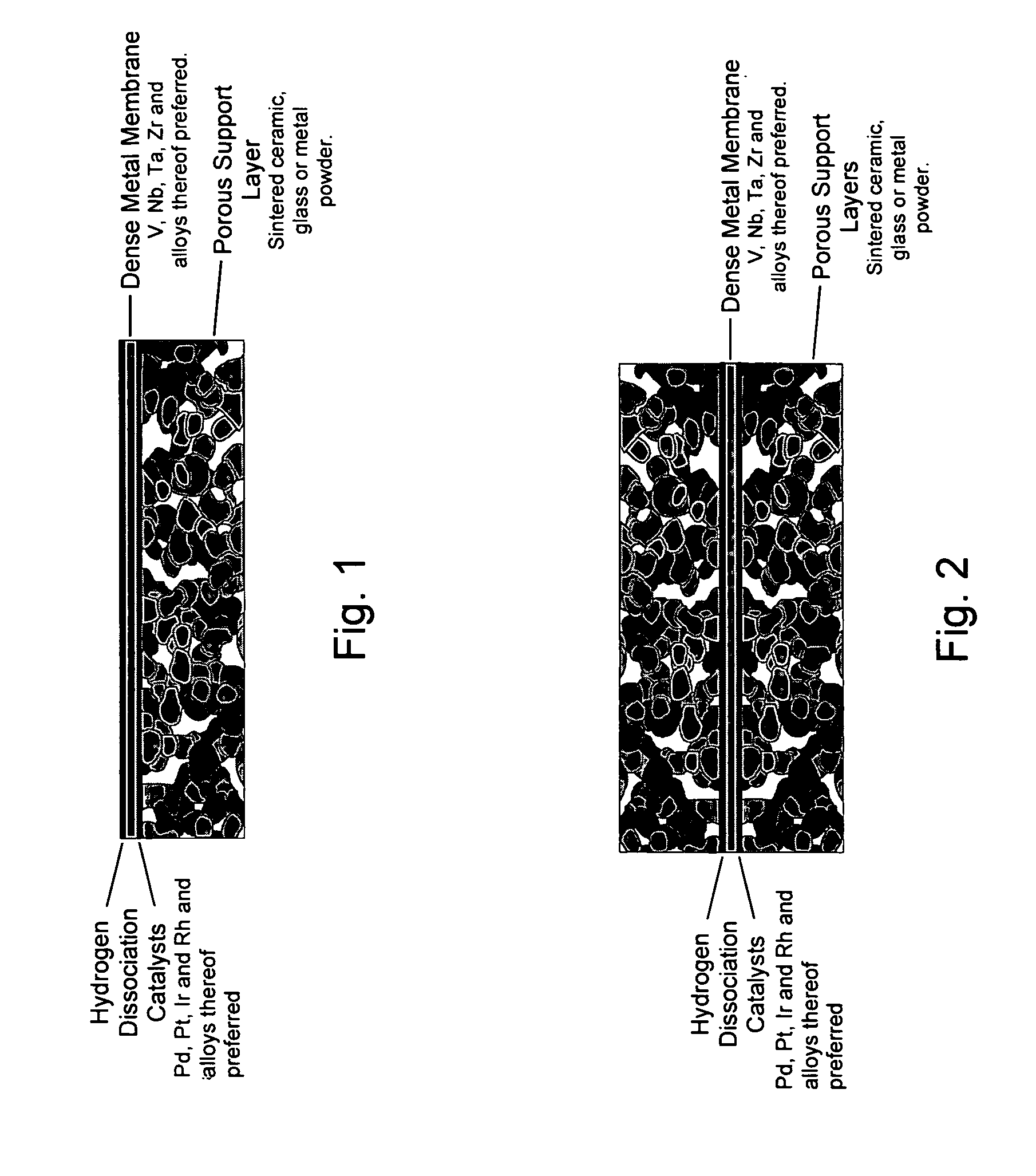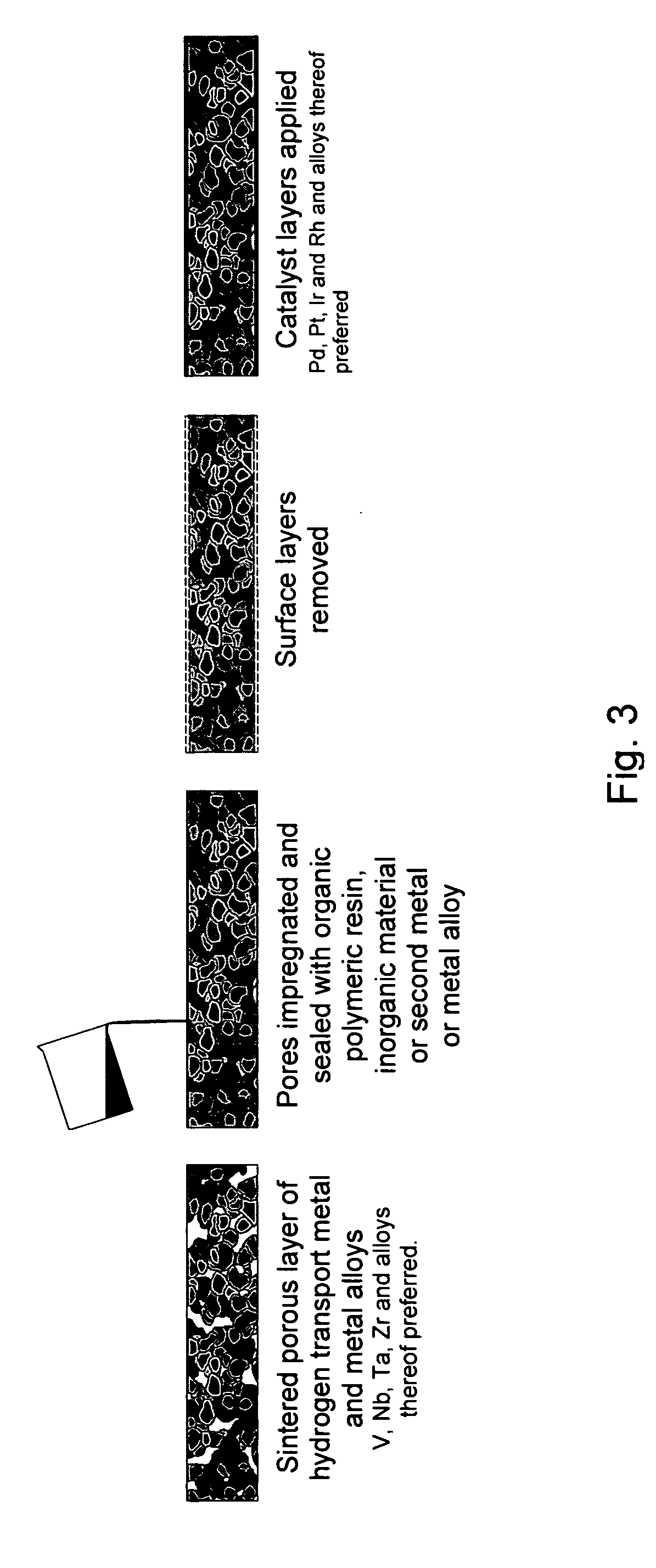[0017] This invention provides composite membranes and methods for production of composite membranes, which are designed for separation of hydrogen from mixtures of gases. These membranes are particularly useful for separating hydrogen from water-gas-shift reaction mixtures containing H2, CO, CO2, N2, H2S, NH3, H2O or other gases, but are not limited to this mixture or this use. In general, it is desired to use metals and
metal alloys which have the highest permeability for hydrogen, but which have negligible permeability for most other gases. Preferred metals include V, Nb, Ta, Zr, Pd, Ni, Fe, Mo and their alloys. More preferred metals are V, Nb, Ta, Zr, Pd, and their alloys. Yet more preferred metals are V, Nb, Ta, Zr and their alloys. Alloys can be binary, ternary or
quaternary alloys containing one or more of V, Nb, Ta, Zr, in combination with other metals, particularly Co, Ni, Ti, Mo, Al, and Mg. A preferred
vanadium alloy is a
binary alloy of
vanadium and
nickel. In order to maximize flux of hydrogen across a membrane, it is highly desirable to minimize the thickness of the hydrogen-permeable
metal layer (or component), while at the same time avoiding the formation of cracks,
tears, or holes which provide leak pathways for undesired gases. The invention provides improved membranes in which hydrogen-permeable metals and metal alloys are mechanically supported and methods for mechanically supporting metals and metal alloys.
[0023] In yet another general embodiment, thin foils of hydrogen-permeable metal are coated with a
ceramic adhesive or paste, which sets to form a rigid, porous support. The thickness of the support is selected to provide sufficient support for the thin foil to enhance useful lifetime of the membrane without significantly inhibiting
hydrogen permeation. In particular the
ceramic layers can range in thickness from about 100 microns to about 500 microns. Alternatively, hydrogen-permeable metal or
alloy foils can be coated on either side with an organic resin to provide a porous support for the hydrogen-permeable foil.
[0024] For each of the general embodiments except those which employ an organic resin, it is preferred to lattice match the hydrogen-permeable metal or
metal alloy with its support or
carrier material in order to produce coherent interfaces between the metal and support. Lattice matching minimizes stress at the internal interfaces, thus reducing the formation of dislocations, leak paths, and sites for
initiation of cracks. In many cases it is preferred to add a catalyst for the dissociation of hydrogen onto one or both sides of the membrane. The hydrogen permeable metal or
metal alloy can be latticed-matched to a
porous metal or
alloy support, a porous
ceramic support or a porous
cermet support. For organic polymers and resins which are not crystalline, lattice matching does not apply to composite membranes in which an organic resin is employed as a porous support for a
thin layer of hydrogen-permeable metal or alloy or to composite membranes in which an organic resin is employed to block the pores of a porous matrix of hydrogen-permeable metal or alloy.
[0031] In a specific embodiment, the porous carrier, including ceramic, metal or
metal alloy carriers, onto which the metallic layer is introduced and the metal or metal alloy to be introduced onto the carrier are selected such that the lattice constants of the
carrier material and those of the metal or metal alloy to be introduced are substantially matched to provide a good epitaxial / endotaxial fit.
[0033] If the metal layer and
porous substrate or carrier are made of identical metal or metal alloy, lattice constants, are in principle identical. In general, it is preferred to select materials for the
composite membrane to maximize lattice matching to decrease mechanical stress. However, the use of materials (ceramic and metal) the lattice constants of which are less well matched may be beneficial to improve other properties of the membrane, for example, in cases where the
porous layer is designed to possess catalytic properties for hydrogen dissociation.
[0061] In a specific embodiment, the
hydrogen transport membrane of this invention comprise a porous ceramic into the pores of which is deposited a substantially metallic layer which renders the porous ceramic impermeable to gases other than hydrogen. The substantially metallic layer comprises a metal or metal alloy. Preferred metals are Pd, Ta, Nb, V, Zr, Ni, Co and Fe. The substantially metallic layer is sufficiently thin to enhance the rate of
hydrogen transport without substantial transport of other gases.
 Login to View More
Login to View More  Login to View More
Login to View More 


